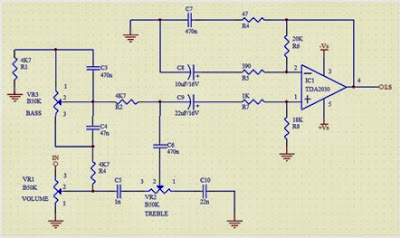Gratis Symmetrical Opamp Supply Voltages Circuit Diagram
Many ways to obtain a set of symmetrical supply voltages for operational amplifiers and comparators from a single +5-V sup-ply voltage have been described already. The simplest option (including with regard to component availability and price) is to use a MAX232, which is available in the 16-pin DIP package for less than 30 p (50 eurocents).
In nearly all microcontroller circuits with an RS232 port, this IC is already present any-way to provide level conversion between TTl signals (5 V) and RS232 signals (nominally ±12 V), so you can obtain a set of symmetric supply voltages for opamps almost free of charge.
In nearly all microcontroller circuits with an RS232 port, this IC is already present any-way to provide level conversion between TTl signals (5 V) and RS232 signals (nominally ±12 V), so you can obtain a set of symmetric supply voltages for opamps almost free of charge.
Gratis Symmetrical Opamp Supply Voltages Circuit Diagram

It ’s not even necessary to add any circuitry around the IC. Figure 1 shows how a MAX232 is typically wired in a microcontroller circuit.The symmetrical voltages (at around ±9 V) generated from the +5-V supply voltage can be taken from pin 2 (V DD; +9 V) and pin 6 (VEE, –9 V) of the IC.
As you can see from Figure 2, the no-load voltage is nearly 10 V and you can draw up to 5 mA at 9 V, which is enough for most standard opamps and plenty for low-power opamps.

The MAX232 has two charge pumps, each of which has two external capacitors for voltage doubling. These are 10-µF electrolytic capacitors in Figure 1, which yields a somewhat stabler output voltage than the standard circuit with 1 µF as shown in Figure 2. The charge pumps of the MAX232 are operated at an oscillator frequency of around 50 kHz, so the amount of ripple on the output voltage is quite small (typically less than 10 mV with a 2-mA load).

This means that in most cases you can manage without any additional filtering of the output voltage. In sensitive applica-tions, such as amplification of small audio or measurement signals by one or more opamps, it’s a good ideal to use a small gyrator circuit for additional suppression of the residual 50-kHz signal. Figure 3 is an example of such a circuit that has been proven frequently in practice. Of course, you can use other types of complimentary small-signal silicon transistors, such as the BC547 (NPN) and BC577 (PNP), in place of the BC550 (NPN) and BC560 (PNP) shown on the schematic.
Transistors in the current gain class ‘B’ (such as the BC547B and BC557B) are also suitable, and the values of the capacitors between the bases of the transistors and ground can also be increased (e.g. 100 µF) or decreased (e.g. 1 µF). The voltage drop across the gyrator circuit is only around 0.7 V.
Transistors in the current gain class ‘B’ (such as the BC547B and BC557B) are also suitable, and the values of the capacitors between the bases of the transistors and ground can also be increased (e.g. 100 µF) or decreased (e.g. 1 µF). The voltage drop across the gyrator circuit is only around 0.7 V.



Comments
Post a Comment